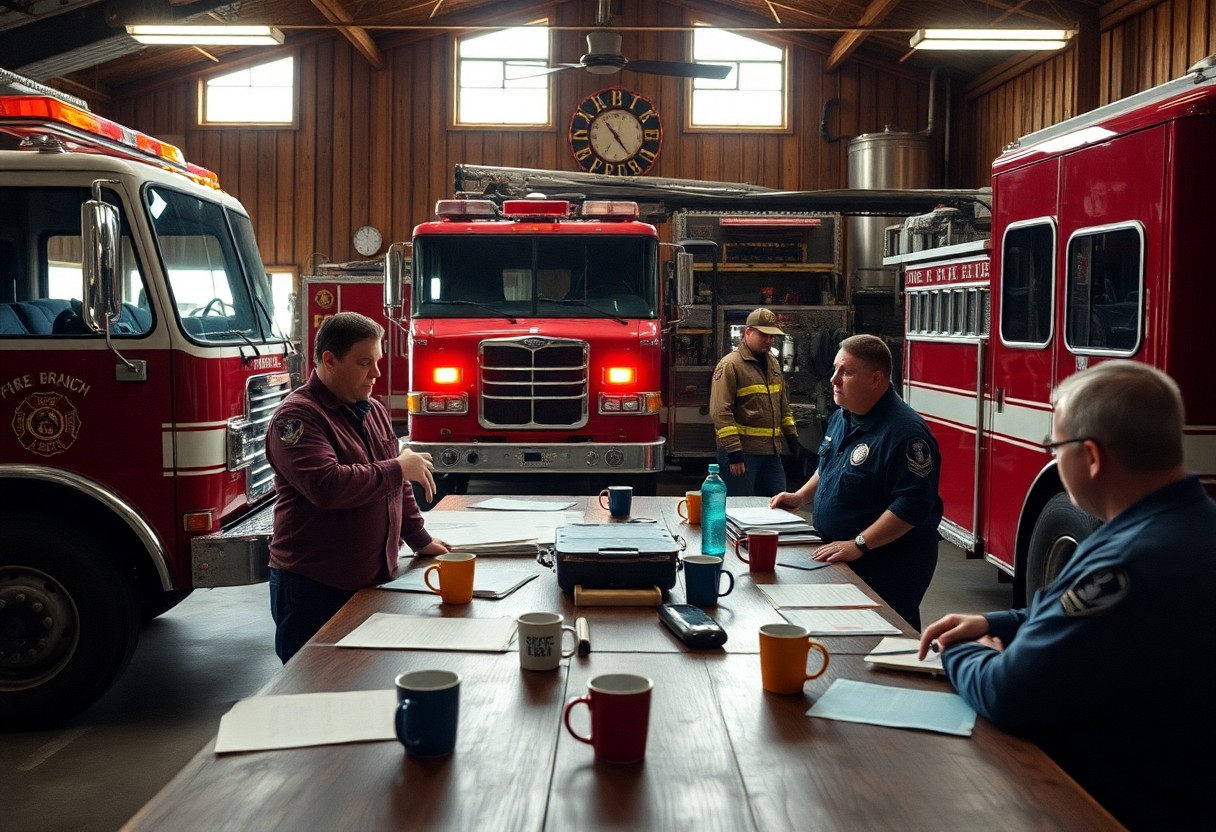With the ever-increasing need for effective firefighting resources in rural areas, you may find yourself exploring various funding options. Non-FEMA grants offer financial assistance specifically tailored for fire departments, enabling you to enhance equipment, training, and community outreach. From federal programs to private foundations, there are several grant opportunities available that can significantly impact your department’s ability to serve and protect your community. In this post, you will discover the types of non-FEMA grants you can pursue to ensure your fire department is well-equipped for any emergency.
Key Takeaways:
- Various non-FEMA grants are available for rural fire departments, including state-specific funding programs, USDA Rural Development grants, and private foundation grants aimed at enhancing fire safety and equipment.
- Many non-profit organizations and local businesses partner with fire departments to provide financial support, often resulting in tailored grants specific to the needs of rural communities.
- Fire departments should actively explore grant opportunities within their state, consider collaborating with nearby departments, and engage in community fundraising efforts to increase chances of securing funding.
The Landscape of Rural Firefighting Funding
Funding for rural fire departments must navigate a complex landscape that includes various local, state, and private resources. Traditional grants such as those from FEMA are often insufficient to meet the unique needs of rural firefighting, which can involve older equipment and larger geographic areas of responsibility. As a result, many fire departments rely on a mix of funding sources, from community fundraising events to specialized grants tailored for rural or volunteer firefighters. Each of these funding streams contributes to building more resilient firefighting capabilities in less urbanized regions.
Unique Challenges Faced by Rural Fire Departments
Your rural fire department likely juggles several challenges, including operating on tight budgets, limited access to advanced firefighting technology, and vast response areas that can hinder response times. Fewer volunteers and a lack of full-time personnel further complicate the situation, as does the increasing demand for emergency services amid growing populations in rural communities. This combination of factors not only strains resources but also jeopardizes effective readiness for emergencies.
Importance of Non-FEMA Funding Sources
Exploring non-FEMA funding sources becomes vital for your rural fire department, as it provides additional financial resources to tackle the unique obstacles you face. Alternative grants and funding opportunities can bolster your equipment and training resources, ultimately enhancing your community’s safety. Additionally, these non-traditional avenues allow you to diversify your income streams, reducing reliance on federal or state funding alone.
Non-FEMA funding sources can fill critical gaps in your budget. For example, local businesses often sponsor community events that can raise funds for fire safety gear or training programs, while foundations dedicated to improving community safety may offer grants specifically for rural firefighting initiatives. Engaging with these resources not only supplements equipment purchases but also fosters community support, encouraging local residents to actively participate in emergency preparedness efforts. This holistic approach can lead to a more robust firefighting capability tailored to the unique needs of your region.
Community-Based Grant Opportunities
Local resources often play a significant role in ensuring the sustainability of your fire department. Community-based grants can be found through a variety of sources that focus on improving public safety and enhancing local emergency response capabilities. These opportunities encourage a grassroots approach to funding, allowing you to tap into the support of your community while addressing specific needs unique to rural fire services.
Local Foundations and Trusts
Many local foundations and trusts are dedicated to enhancing community resilience and safety. These organizations provide financial assistance to fire departments through grant programs that focus on equipment purchases, training, and community outreach initiatives. Building a relationship with these foundations can lead to consistent support as you demonstrate your department’s impact on local safety.
Collaborative Community Initiatives
Partnering with other local organizations can amplify your funding efforts through collaborative community initiatives. By pooling resources and aligning objectives with schools, health organizations, and civic groups, you can create comprehensive programs that not only address fire safety but also improve overall community health and preparedness. This synergy often opens doors to additional funding opportunities that might not be available to independent organizations.
Engaging in collaborative community initiatives can significantly boost your fire department’s visibility and credibility. For instance, a partnership with local schools on fire safety education can tap into educational grants focused on youth programs. In a successful case, a rural fire department teamed up with a health organization to launch an awareness campaign on home fire prevention, resulting in a shared grant of $50,000. Such collaborations create mutual benefits, leading to enhanced community safety while allowing you to secure vital funding in a competitive landscape.
Federal Non-FEMA Programs Supporting Fire Services
Numerous federal programs beyond FEMA can bolster fire departments in rural areas, focusing on critical resources to enhance firefighting capabilities and community safety. These initiatives aim to address equipment needs, training, and operational costs, serving as vital lifelines for departments operating with limited budgets. You can tap into specific grants designed for your unique challenges, ensuring you’re equipped to address emergencies effectively and efficiently.
The Assistance to Firefighters Grant Program
The Assistance to Firefighters Grant Program (AFG) provides vital funding to help fire departments increase their capabilities, including training and equipment purchases. This grant specifically targets departments that demonstrate the greatest need, with a focus on improving firefighting and emergency response services. By participating in this program, you can apply for substantial funding to enhance your department’s resources.
U.S. Department of Agriculture Rural Development Grants
The U.S. Department of Agriculture (USDA) Rural Development Grants offer additional financial assistance tailored for rural fire departments. These grants aim to support departments in purchasing necessary equipment and improving facilities, promoting enhanced services in underserved communities. With an eye toward strengthening your operational capacity, these grants can bridge significant funding gaps.
USDA Rural Development Grants are particularly valuable for rural fire departments facing unique challenges, such as geographic isolation and reduced access to funding. Programs like the Community Facilities Grant Program can provide funding for critical infrastructure improvements, which can enhance your firefighting capabilities and overall service delivery. By leveraging these grants, you can secure funding for equipment upgrades, facility renovations, and even training initiatives that bolster your team’s effectiveness in responding to emergencies. Taking advantage of these resources significantly contributes to the safety and wellbeing of your community.
Corporate Sponsorships and Philanthropic Support
Building strong partnerships with local corporations and philanthropic organizations can significantly bolster your fire department’s funding strategies. Many businesses seek to give back to their communities through sponsorships or donations, especially if they understand the critical role your department plays in ensuring public safety. Engaging these entities not only brings financial support but also fosters a sense of unity and shared purpose between your department and the community.
Navigating Corporate Social Responsibility Programs
Corporate Social Responsibility (CSR) programs often provide a gateway to funding opportunities. Many companies allocate a portion of their profits toward community development and public safety initiatives. By presenting your fire department’s mission and needs clearly, you position yourself as a candidate for these CSR funds. Research local businesses that prioritize safety and community engagement, as their objectives may align closely with your needs.
Building Relationships with Local Businesses
Reaching out to local businesses for support can create lasting partnerships that benefit both your fire department and the community at large. Establishing connections involves regular communication, sharing your department’s achievements, and demonstrating how their involvement impacts public safety. Organizing community events, such as safety fairs or open houses, can serve as platforms for showcasing these alliances.
As you build relationships with local businesses, focus on mutual benefits. For instance, offering promotional opportunities at department events ensures that businesses gain visibility while supporting your fire department. Creating tailored sponsorship packages that outline specific benefits, such as logo placements or mentions in press releases, can make contributions more attractive. Collaborating on educational programs can also enhance community awareness, solidifying the relationship and encouraging ongoing support. Recognizing and thanking sponsors for their contributions through social media shout-outs or community newsletters can foster goodwill and incentivize further engagement.
Tips for Crafting Successful Grant Applications
Creating a standout grant application requires a strategic approach. Start by meticulously reading the grant guidelines to ensure your project aligns with funding priorities. Highlight your fire department’s unique strengths, significance within the community, and how the funds will directly benefit your operations. Engaging your reviewers with clarity and passion can truly affect their decision. Be sure to include specific details and bolster your application with supporting documents.
- Align project needs with funder objectives
- Provide clear, quantifiable outcomes
- Engage in community involvement
- Proofread for clarity and professionalism
Any grant application that resonates with your mission will stand a better chance of success.
Developing a Compelling Narrative
Your narrative should illustrate not just the needs of your fire department, but also its impact on the community. Use storytelling techniques to convey your history, challenges, and aspirations. Showcase volunteers, highlight past successes, and connect emotionally with the reader by depicting real-life scenarios your department has addressed. This creates a compelling reason for funders to support your mission, illustrating how their investment directly influences safety and community well-being.
Gathering Essential Data and Support Materials
Strong data and support materials can significantly enhance your grant application. Collect statistics that demonstrate your department’s performance, volunteer hours, and community engagement initiatives. Images of community events and testimonials from residents or local officials can also lend credibility to your application. These elements provide tangible evidence of your department’s impact, helping funders visualize their potential contributions.
Particularly, ensure you gather both quantitative and qualitative data that supports your project goals. For example, detailing the number of emergencies your department responded to over the past year alongside graphical representations of community impact can strengthen your case. Statistical data, such as response times or breakdowns of rescue efforts, allows funders to grasp the urgency of your needs. Testimonials can provide a human touch, painting a picture of real-life experiences and the direct benefits of your services. Including letters of support from local officials or community leaders can bolster your application and demonstrate a shared commitment to your objectives.
Conclusion
On the whole, various non-FEMA grants are available for fire departments in rural areas, helping you enhance your resources and capabilities. These include federal grants from the Department of Agriculture and the Department of Homeland Security, as well as state and local funding options. Additionally, private foundations and community-based programs can provide financial support tailored to your specific needs. By exploring these opportunities, you can secure the necessary funding to improve your fire protection services and better serve your community.



